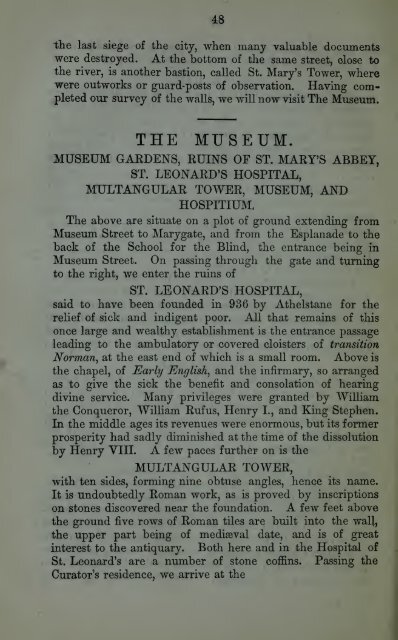practicalguideto00unse_0
You also want an ePaper? Increase the reach of your titles
YUMPU automatically turns print PDFs into web optimized ePapers that Google loves.
48<br />
the last siege of the city, when many valuable documents<br />
were destroyed. At the bottom of the same street, close to<br />
the river, is another bastion, called St. Mary's Tower, where<br />
were outworks or guard-posts of observation. Having com-<br />
;pleted our survey of the walls, we will now visit The Museum.<br />
THE<br />
MUSEUM.<br />
MUSEUM GARDENS, EUINS OF ST. MARY'S ABBEY,<br />
ST. LEONARD'S HOSPITAL,<br />
MULTANGULAR TOWER, MUSEUM, AND<br />
HOSPITIUM.<br />
The above are situate on a plot of ground extending from<br />
Esplanade to the<br />
Museum Street to Marygate, and from the<br />
back of the School for the Blind, the entrance being in<br />
Museum Street. On passing through the gate and turning<br />
to the right, we enter the ruins of<br />
ST.<br />
LEONARD'S HOSPITAL,<br />
said to have been founded in 936 by Athelstane for the<br />
relief of sick and indigent poor. All that remains of this<br />
once large and wealthy establishment is the entrance passage<br />
leading to the ambulatory or covered cloisters of transition<br />
Norman^ at the east end of which is a small room. Above is<br />
the chapel, of Early English^ and the infirmary, so arranged<br />
as to give the sick the benefit and consolation of hearing<br />
divine service. Many privileges were granted by William<br />
the Conqueror, William Rufus, Henry I., and King Stephen.<br />
In the middle ages its revenues were enormous, but its former<br />
prosperity had sadly diminished at the time of the dissolution<br />
by Henry VIII. A few paces further on is the<br />
MULTANGULAR TOWER,<br />
with ten sides, forming nine obtuse angles, hence its name.<br />
It is undoubtedly Roman work, as is proved by inscriptions<br />
on stones discovered near the foundation. A few feet above<br />
the ground five rows of Roman tiles are built into the wall,<br />
the upper part being of mediseval date, and is of great<br />
interest to the antiquary. Both here and in the Hospital of<br />
St. Leonard's are a number of stone coffins. Passing the<br />
Curator's residence, we arrive at the















